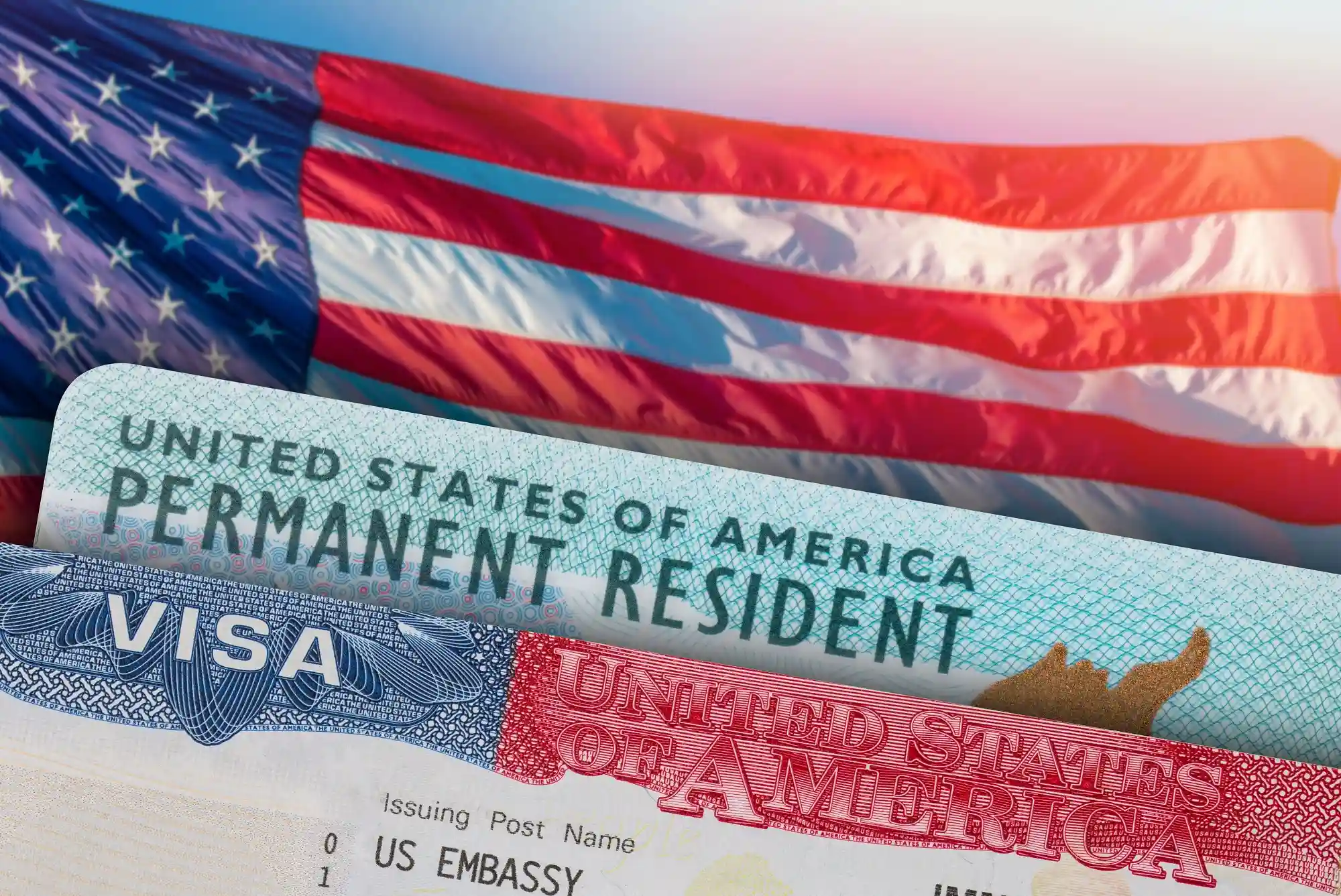If you’re hoping to get a green card, you might be thinking: Should I adjust my status in the U.S. or go through consular processing abroad? Both options lead to lawful permanent residency, but the paths (and the risks) are very different.
This guide explains the primary differences between consular processing and adjustment of status, the latest rule changes, and how to decide which route fits your situation best. Because the stakes are high, we advise applicants to consider hiring an adjustment of status lawyer to ensure that their applications have the best chance of approval.
Adjustment of Status vs. Consular Processing: Quick Comparison
Let’s start with an overview of the basics:
Both processes end with the same result: a green card granting lawful permanent residence. However, they differ in terms of cost, paperwork, and timing.
What Is Adjustment of Status?

Adjustment of status (AOS) is how eligible immigrants who are already in the U.S. apply for a green card without leaving the country. It’s available to certain applicants who have been inspected or paroled into the U.S. and have a current priority date (meaning their immigrant visa number is available).
Think of it like this: You’re already in line inside the country, and instead of starting over abroad, you finish the process where you are.
Who Can Get Their Status Adjusted?

You may qualify for AOS if you:
- Are physically present in the U.S.
- Have a valid entry through a non-immigrant visa like F-1, H-1B, or a visitor visa.
- Have an approved immigrant petition (for example, I-130 for family or I-140 for employment).
- Have an immigrant visa number available according to the Visa Bulletin.
- Are admissible or qualify for a waiver.
Some refugees or asylum status holders can also apply for adjustment after one year in the U.S. Others, such as those who entered without inspection or violated their lawful status, may not qualify unless covered by special provisions.
Forms and Fees
USCIS implemented major fee changes starting April 1, 2024. Here’s what most status applicants pay as of 2025:
- Form I-485 (Application to Register Permanent Residence or Adjust Status): $1,440
- Form I-765 (Application for Employment Authorization): $260
- Form I-131 (Application for Travel Documents, Parole Documents, and Arrival/Departure Records): $630
Since these forms are no longer bundled, most applicants pay over $2,000 in total if they apply for all three. Always confirm using USCIS’s fee calculator, as costs differ for children or certain categories.
Visa Availability and Priority Dates

USCIS uses a Visa Bulletin to decide when applicants can file for status adjustment. There are two separate charts:
- Final action dates (when visas can be issued)
- Dates for filing (when you can submit your application)
Each month, USCIS announces which chart applies to AOS filings. It’s a good idea to check their “When to File” page before submitting, since the dates change monthly. Filing too early can lead to rejections or delays.
Working and Traveling While Your Case Is Pending
One major advantage of AOS is that you can remain in the U.S. while your green card is being processed. You can also work legally once you receive your EAD.
However, traveling abroad comes with certain rules:
- If you leave the U.S. before getting Advance Parole, USCIS will treat your case as abandoned.
- The exception is that applicants with valid H-1B/H-4 or L-1/L-2 status can travel and re-enter on those visas without abandoning their applications.
Always discuss your travel plans with an immigration lawyer before leaving the country to avoid unintended immigration violations.
The Required Medical Exam
All adjustment of status applicants must complete a mandatory medical exam by a USCIS-approved civil surgeon. As of 2025, the rules are stricter:
- Forms signed on or after November 1, 2023, are valid only while the green card case is pending.
- If your application is denied or withdrawn, the exam can’t be reused for a new filing.
It’s wise to schedule your exam close to your interview date to keep it current.
What Is Consular Processing?
Consular processing is the path for applicants outside the U.S. (or those not eligible for AOS) to apply for an immigrant visa at a U.S. consulate abroad. Once the visa is issued and you enter the United States, you become a lawful permanent resident automatically.
Here’s how it works:
- Your immigrant petition (I-130 or I-140) gets approved by USCIS.
- The case is transferred to the National Visa Center, which collects fees and supporting documents.
- You complete Form DS-260, the immigrant visa application.
- You attend a required medical exam with an embassy-approved physician.
- You appear for your interview with a consular officer.
- If approved, you receive your visa packet and instructions to pay the USCIS immigrant fee.
Once you land in the U.S., you can officially register for permanent residence status and receive your green card in the mail.
Do You Have to Leave the U.S. to Start Consular Processing?

Not necessarily. You can pay fees, upload documents, and communicate with the NVC while still in the U.S. The key is to leave for your immigrant visa interview, which is the final step before approval.
That being said, if you’ve been in the country unlawfully, departing the U.S. can trigger serious barriers to reentry.
Costs and Processing Times in 2025
Both adjustment of status and consular processing involve multiple fees and unpredictable wait times. Here’s what to expect:
Adjustment of Status Expenses
- Form I-485: $1,440
- EAD (I-765): $260
- Advance Parole (I-131): $630
- Medical exam: $200–$600
- Attorney fees (if applicable): Varies by case
Consular Processing Expenses
- NVC fees (IV and Affidavit of Support): About $445 total
- Medical exam: $200–$600 (heavily dependent on country)
- USCIS immigrant fee: $235
- Travel costs: Varies by case
Processing Times
- Adjustment of status: 7–20 months, depending on the USCIS field office
- Consular processing: 6–18 months, depending on embassy backlogs
These numbers fluctuate from month to month, so make sure to check the latest timelines directly on USCIS’s processing times page or your local consulate’s website.
Travel Rules for AOS Applicants

If you’ve applied to adjust your status, traveling outside the U.S. isn’t as simple as booking a flight.
Here are some general guidelines to be aware of:
- Without advance parole: Leaving the U.S. usually means USCIS will deny your case.
- With advance parole: You can travel and return safely.
- Status exception: H-1B/H-4 and L-1/L-2 holders can travel with valid visas and re-enter without abandoning their green card case, per 8 CFR 245.2(a)(4)(ii).
In other words, if you have valid work status, you have more flexibility (but always double-check before departure).
Direct Consular Filing
Direct consular filing allows a U.S. embassy or consulate to accept an immigrant petition directly in exceptional circumstances, such as humanitarian emergencies, military deployments, or cases where the petitioner lives abroad.
This route can shorten your wait time dramatically, but most consulates restrict it to urgent situations. Don’t count on this option unless you meet the strict criteria.
How to Decide Between Adjustment of Status and Consular Processing
Choosing the right path comes down to your individual situation. Consider these factors:
- Where you are now: If you’re legally in the U.S. with valid status, AOS may be smoother.
- Your immigration history: Prior overstays or unauthorized entries often make consular processing safer (with waiver planning).
- Timing: If your consulate has shorter processing times, that may outweigh the convenience of staying in the U.S.
- Your work and travel needs: AOS gives you employment authorization, while CP doesn’t let you work until you enter with your green card.
- Your family situation: If you have unmarried children or family members applying as derivatives, think about how travel and wait times may affect them.
- Medical and background checks: Both options require them, but consular interviews may involve additional security screening and administrative review.
A consultation with an experienced immigration lawyer can clarify which option will best protect your lawful status and help you meet your long-term goals.
What to Bring to Your Interview

For Adjustment of Status
- Appointment confirmation letter
- Original civil documents (birth certificate, marriage license, divorce decree, etc.)
- Government-issued ID and passport
- Updated medical exam (I-693) if not previously filed
- Recent tax returns and pay stubs
- Proof of genuine relationship (for marriage-based cases)
For Consular Processing
- Appointment confirmation letter
- Original civil documents (birth certificate, marriage license, divorce decree, etc.)
- Passport valid for at least six months
- Visa packet from NVC
- Supporting documents uploaded through CEAC
- Affidavit of Support (I-864) with current proof of income
Plan on bringing both originals and photocopies, as missing items could delay your final decision.
Frequently Asked Questions
Can I travel while my adjustment of status is pending?
Only with Advance Parole, unless you’re maintaining valid H-1B, H-4, L-1, or L-2 status.
Do I need to leave the U.S. to start consular processing?
No. You can complete the steps required by the NVC while in the U.S. You must travel abroad only for your immigrant visa interview.
How long is the medical exam valid in 2025?
If signed on or after November 1, 2023, the medical exam will stay valid only while your case is pending, and it can’t be reused for a new filing.
What if USCIS denies my adjustment of status?
You may be able to refile, appeal, or pursue consular processing instead. Review the denial notice carefully and hire qualified legal counsel before responding.
Can I work while waiting for my green card?
Yes, if you apply for and receive an EAD during adjustment of status. Consular processing applicants must wait until they enter the U.S. as residents.
Reunite Your Family with SimVisa
No two immigration journeys look exactly the same. Whether you plan to adjust your status inside the U.S. or pursue consular processing abroad, your choice will impact everything from processing times and travel restrictions to the risk of unlawful presence bars.
The helpful team at SimVisa can guide you through every step of the application process. We’ll evaluate your eligibility, confirm that your supporting documents meet the latest requirements, and help you avoid costly mistakes that could lead to administrative review or denial. Contact us today to start off on the right foot.












